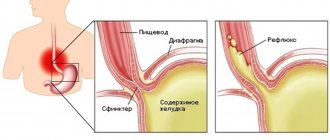The problem of bad breath plagues almost the entire population of the world. It is often quite simple to deal with it by brushing your teeth with a refreshing paste on your toothbrush. However, in some situations, if the smell thins out the aroma of rot, this is quite difficult to do. This disease is called halitosis, and by its nature it causes its owner not pain, but psychological problems, sometimes leading to depression.
That is why the putrid smell should be gotten rid of immediately in order to lead a normal personal life and good communication. To do this, the first thing you should do is find out the root cause of such an unpleasant odor and the possibility of curing it.
Sources of halitosis
The smell of rotten breath is a serious reason to visit the dentist.
itself is an unpleasant, persistent odor from the mouth that cannot be eliminated with home hygiene products.
This problem, in its essence, is not a disease at all, but simply helps a person understand that there are disorders in the body.
This is why the first thing a person should do is see a dentist, as the source can often be found in the oral area. Only after this, if the dentist is unable to detect it, does an examination of the internal organs begin.
Doctors include the most well-known sources of disgusting odor:
- problematic teeth - the presence of caries, inflammation of the gums and bone tissue, improper treatment when placing a filling, stomatitis;
- fungal infection or disturbances in the functioning of the salivary glands, especially in old age, when the flow of saliva becomes much less;
- diseases of internal organs - intestines, pulmonary and endocrine systems;
- The appearance of bad breath in women can provoke menstruation ;
- inflammation in the body .
What to pay attention to
If any problems arise, you should contact your dentist as soon as possible. We recommend coming for a consultation as soon as you notice:
- The appearance of an unpleasant putrid odor.
- It feels like something is stuck under the crown.
- Change in gum color, swelling, swelling, pain.
- The appearance of blood while brushing your teeth.
- Darkening of the abutment tooth.
When a tooth is prepared for a crown, the nerve endings are removed. Therefore, secondary caries passes painlessly. It can only be noticed by indirect signs. But these symptoms indicate that some pathological process is developing in the oral cavity. You should see a doctor immediately. Delaying a visit to the clinic will cause the inflammatory process to develop quickly.
Untreated inflammation under the crown is one of the most common causes of loss of an abutment tooth. A heavily damaged support unit cannot always be preserved. Most likely it will have to be removed and then re-prosthetics done.
Causes of unpleasant odor
The source of halitosis can be not only dental problems, but also diseases of internal organs.
In general, all the causes of the unpleasant smell of rotten breath can be divided into 2 large groups:
- physiological stem from poor diet and terrible oral hygiene;
- Pathological causes are influenced by more serious problems with internal organs and dental diseases.
| Reason for the smell | Main features | Associated symptoms |
| Disorders in the gastrointestinal tract | With increased acidity in the stomach, ulcers and gastritis, sour breath occurs. Dysbacteriosis and intestinal obstruction – heavy aroma of feces. In case of low acidity or poisoning - hydrogen sulfide. | The most common symptoms are nausea and vomiting. There is a constant bitterness in the mouth. Constipation, diarrhea and stomach pain are characteristic of gastrointestinal diseases |
| Respiratory diseases | Smells like rot and pus | Severe shortness of breath, sometimes turning into suffocation, cough: dry or wet depending on the illness, coughing up blood |
| Severe caries in an advanced stage | Rotten smell of rotten meat | Acute but short-term pain with shooting, brown spots on the teeth |
| Presence of dentures in the mouth | Putrid aroma | A large number of bacteria accumulate on dentures |
| Diseases of the ENT system | The odor usually resembles that of pus, but depending on the disease, it may be stronger. | Immune system disorders, inflammation in damaged areas, high body temperature, discharge from the ears and nose, pain |
| Constant smoking | The aroma of rot and the specific aroma of tobacco | Dry mouth, gray skin |
| Disorders of the salivary glands | Fetid smell of rot | Dry mouth due to low saliva production, shooting pain in damaged saliva and swelling |
| Diabetes mellitus type 1 and 2 | Unpleasant smell of acetone and fruits | Constant fatigue, frequent urination, constant hunger and thirst, numbness in the arms and legs |
| Liver failure | Smells like rotten fish and ammonia | Bitterness in the mouth, nausea, jaundice, muscle weakness, shortness of breath |
| Periodontitis | Sulfur scent | Food getting between the teeth, feeling of their unsteadiness, discomfort when chewing, formation of pockets in the gums |
Reasons for the development of pathology
According to dentists, the problem may be due to a number of reasons:
- Low quality dental products. The design does not fit tightly in the area of the tooth neck, as a result of which food and bacteria get under it.
- Insufficient oral hygiene. Pieces of food stuck in the interdental space begin to rot, resulting in a carious process.
At an advanced stage of caries, a space is formed next to or under the denture, into which food particles fall and decay begins. This contributes to the appearance of unpleasant sensations from the mouth.
Putrid breath in children and adolescents
If your child has bad breath, pay attention to the accompanying symptoms.
Children may experience bad breath due to many reasons. It can affect anyone, from infants to teenagers. The main factor is almost always the increased proliferation of bacteria and other pathogenic microbes in the tongue area or on the tonsils.
Serious internal diseases at this age develop quite rarely, so the first thing you should pay attention to is oral hygiene and the balance of microflora.
- The first thing you should pay attention to is saliva. Often there may be severe dryness in the mouth, which leads to the appearance of aroma. It occurs due to a chronic runny nose, growths on the tonsils, or frequent mouth breathing, especially during sleep.
- The second most likely factor is the appearance of caries and the development of other dental diseases; this issue is especially relevant in adolescents when wisdom teeth begin to appear, and in infants during the teething period, accompanied by inflammation.
- The appearance of diseases of the gastrointestinal tract.
In any case, if bad breath appears, parents should take the child for a comprehensive examination to identify the root cause and timely treatment.
Symptoms of tooth decay
The process of rotting under the crown proceeds unnoticed and painlessly, because the nerves have been removed. Painful sensations appear later, when the inflammatory process spreads to the gums, and this is a step towards the loss of “neighboring” completely healthy dental units. Immediate consultation with a dentist is necessary if you notice:
- the appearance of a gap between the crown and gum;
- small particles of food getting under the denture;
- an unpleasant odor that reappears even after comprehensive cleaning and rinsing with an antiseptic;
- blackening of the base of the tooth.
Things to remember:
Tooth destruction is irreversible; even a highly qualified specialist cannot restore its natural integrity. And a timely visit to the dentist will certainly help to avoid complications.
Diagnosis
For self-diagnosis, use dental floss.
It is quite easy to determine whether a person has a problem with bad breath, even at home. Objectively, it is best to use another person for this, who will tell you the result.
You can use dental floss to detect plaque by running it along the tooth. Take a closer look to see if a yellow coating has formed on it, and after 30 seconds, sniff. The aroma that appears will be the result.
Medical institutions use special devices that are designed to detect the amount of unpleasant substances in exhaled air. To more clearly identify the root cause of halitosis, the following methods are used:
- examination of the oral cavity for inflammation, caries and redness;
- blood test to detect inflammatory processes in the body and increased sugar levels in diabetes;
- urine test to detect problems with the renal system;
- examination of the gastrointestinal tract and liver in the form of ultrasound and gastroduodenoscopy;
- inspection of the lingual dorsum.
The doctor must take an anamnesis. As you can see, one dentist cannot make an accurate diagnosis, since the reasons may not only be dental problems, so an otolaryngologist, pulmonologist and gastroenterologist often come to the rescue.
Methods of treating and getting rid of odor
Modern dental treatment methods enable patients to maintain oral health. New materials, drugs, technologies are based on the use of computer technology and digital radiology. Today, lasers are often used and ozone is used to treat the affected areas of the masticatory organs. Sanding is often done with air.
Therapy for bad breath involves identifying and eliminating the cause of the disease. A specialist can determine the provoking factor. Since more than 65 percent of problems relate to diseases of the oral cavity and poor hygiene, you should visit the dentist on time. It is necessary to thoroughly clean the crowns, spaces between units, and tongue. For this purpose, dental floss, rinses, and tongue brushes are used. You need to choose the right toothpaste and use fluoridated products on the advice of your dentist.
Treatment of disgusting oral odor
If the source of the unpleasant odor is the oral cavity, it will require complete sanitation.
If the source of the smell of rot is diseases of the internal organs, then the first step in treatment should be aimed at solving these problems. Here, doctors of individual specializations already come to the rescue, and this happens according to generally accepted standards.
It’s another matter when bad breath is affected by dental diseases.
- If there is a problem with diseased teeth, they are treated or removed if they cannot be saved. The dentist independently determines the recommended course of action.
- Carrying out professional teeth cleaning - the procedure helps to remove all plaque on and under the gums.
- Treatment of inflammation of the gums, sanitization of the mouth, replacement of fillings and dentures if they are installed incorrectly.
- Training from a hygienist in proper independent oral hygiene.
- Correction of salivation to normal when it decreases.
Treatment options for a tooth under a crown
When contacting the clinic, the dentist determines how great the changes are in the dental tissues, and based on the results of the examination, prescribes treatment.
- If the tooth stump has not undergone any changes and rot has not affected it, the doctor cleans out the accumulated food debris from under the crown. Then a new prosthesis or an old one, but corrected, is installed.
- If healthy roots remain, the crown is placed on the stump tab. This device is made in a dental laboratory from an impression and is a structure with peculiar “legs” that are designed to fix the inlay in the tooth canals. And a crown is attached on top.
- If both the upper and root parts of the tooth have rotted, the remains are removed from the mouth and periodontitis is treated. The patient then has to decide on how to restore the tooth. There are two options: implantation or installation of a bridge.
When contacting a clinic for initial prosthetics, it is important to find out at the stage of monitoring institutions whether the clinic provides a guarantee for the treatment provided. If there is a guarantee, then in case of medical errors, treatment and re-restoration are carried out free of charge for the patient.
Pharmaceutical preparations for bad breath.
Pharmacies offer a number of products to help cope with unpleasant odors. Before purchasing, be sure to check that they have antibacterial properties, regardless of the type.
- lollipops will easily freshen your breath for a couple of hours due to their antiseptic properties, which help destroy even bacterial membranes;
- balm contains chlorhexidine, which destroys all bacteria, and essential refreshing oils will make your breath fragrant;
- spray has antimicrobial properties, refreshing the oral cavity and simultaneously providing a disinfectant effect.
Traditional medicine in the fight against bad breath
Use herbal infusions as an adjuvant therapy.
There are many grandmother’s recipes aimed at combating putrefactive odor.
- Mint infusion - put a spoonful of dry mint in a glass, pour boiling water over it and leave to steep for an hour. Then strain and add a few drops of lemon juice or table vinegar. Rinse your mouth with this decoction several times a day for 14 days.
- Chamomile tea – brew dry chamomile (1 spoon) with a glass of water, boil for about five minutes, then drink. This should be done several times a day, each time preparing a new drink.
- Decoction of wormwood - take a couple of spoons of wormwood, brew it with boiling water and let the mixture brew for a while. The rinse aid should be used for a couple of weeks, used 3 times during the day.
- coffee beans into your mouth, then suck them for a quarter of an hour. When conducting an experiment in Israel, it was found that drinking a cup of freshly brewed coffee has the same effect. The aroma from the mouth takes on a specific coffee smell.
Preventive measures
Give up bad habits!
To prevent the occurrence of a problem with an unpleasant odor, prevention should be used. It consists in:
- constant proper oral hygiene, using dental floss and other hygiene products 2 times a day - morning and evening;
- periodic visits to the dentist at least 2 times a year;
- quitting smoking and other bad habits;
- proper nutrition and maintaining optimal water balance in the body;
- timely treatment of the root cause of halitosis;
- add spices to your food - cinnamon and ginger help activate the secretion of saliva.
Prevention of odor
Hygiene is an important point in preventing oral diseases. Teeth should be brushed twice a day. Circular movements are performed over the entire surface of the crowns. At the same time you need to clean your tongue. Its surface is cleaned with a soft brush. You can purchase a special brush.
If the doctor recommended a paste containing calcium, then you need to strengthen the enamel. Antiseptic agents will reduce bacterial activity. This will improve the condition of the gum tissue. After eating, you should rinse your mouth with clean water. It is important to visit the dentist regularly. Prevention of disease is the best treatment. If the oral cavity is in order, but your breath is not fresh, you need to make an appointment with a therapist. You can get rid of halitosis when the disease that caused it is eliminated.









